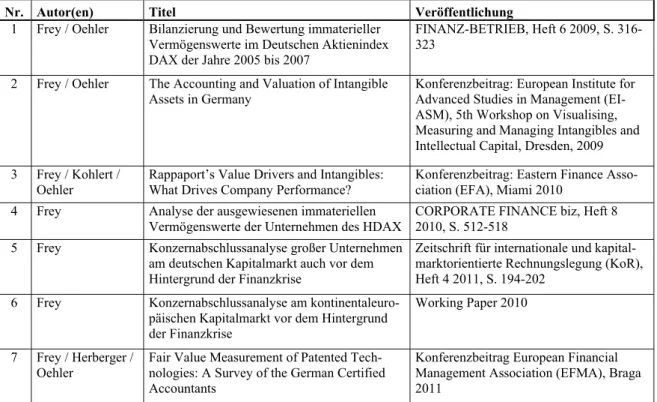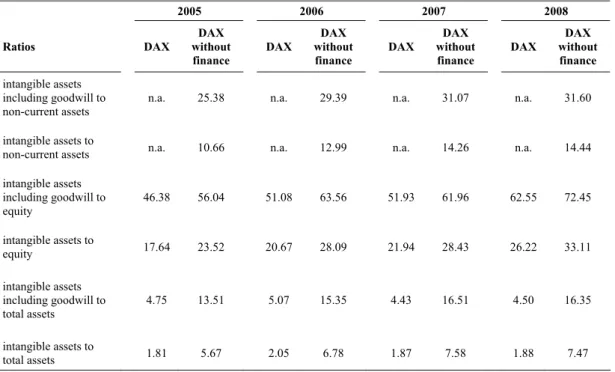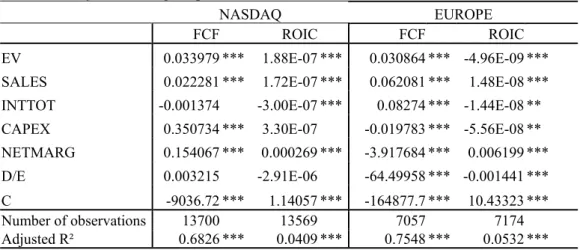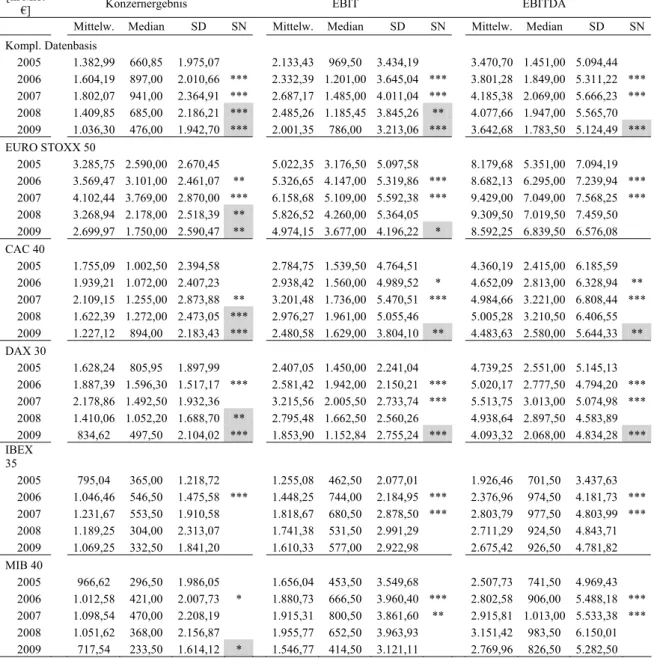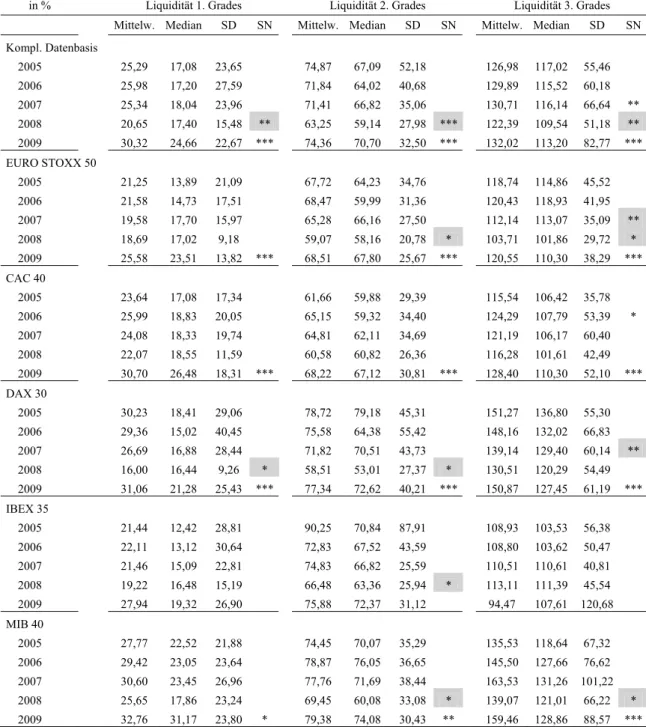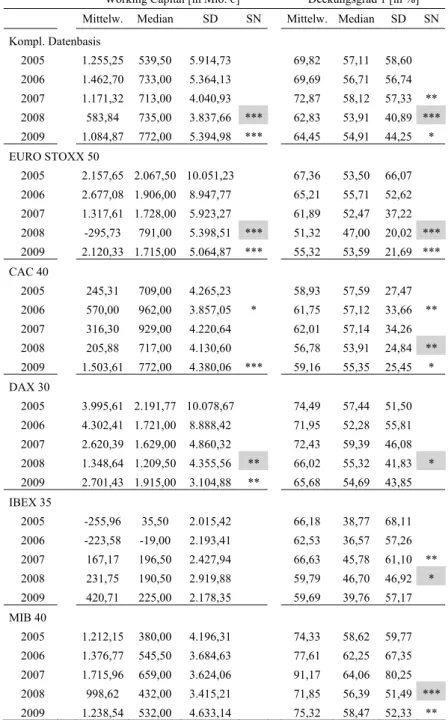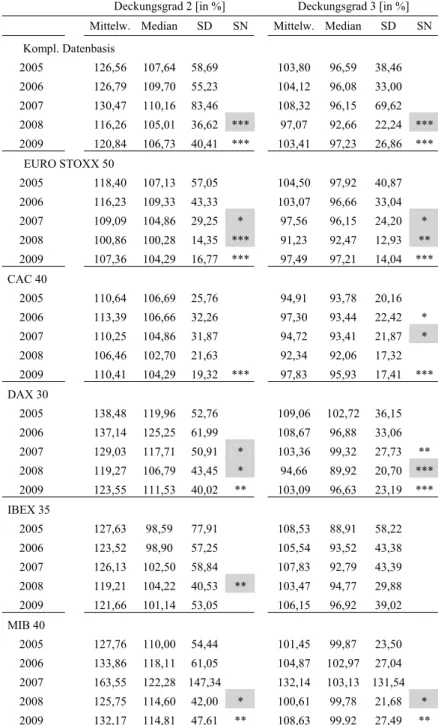Hannes Frey
Immaterielle Vermögenswerte
Bewertung, Bilanzierung und
Unternehmensperformance
Hannes Frey
Immaterielle Vermögenswerte
Bewertung, Bilanzierung und Unternehmensperformance
Mit einem Geleitwort von Univ.-Prof. Dr. Andreas Oehler
Erstgutachter: Prof. Dr. Andreas Oehler
Zweitgutachter: Prof. Thomas Walker PhD
Disputation: 25.05.2011
Geleitwort
Innerhalb des Forschungszweiges der finanzwirtschaftlich ausgerichteten, internationalen Rechnungslegung (Financial Accounting), insbesondere der Bilanzierung und Bewertung, und im Rahmen der regulatorischen und praxisbezogenen Realisationen der Wirtschafts- prüfung wird bislang wenig der Fokus auf die Einflussgrößen der Bewertung immaterieller Vermögenswerte gerichtet und die Verbindung zur aktuellen Finanzkrise und zur finanz- wirtschaftlichen Performance von Unternehmen geknüpft. Man gewinnt bisweilen den Eindruck, dass die marktwirtschaftlich grundsätzlich gerechtfertigte Orientierung an den Eigentümern und Eigenkapitalgebern (Shareholder) den Blick für die gleichzeitige Rele- vanz für die – auch regulatorische – Infektionsgefahr durch krisenhafte Phänomene in den Finanz- und Wirtschaftssystemen westlicher Industriestaaten verstellt. Offenkundig wird dies im regulatorischen Wandel der Bilanzierung und Bewertung immaterieller Vermö- gensgegenstände in einem globalisierten Umfeld und im Abbild der aktuellen Finanz- und Wirtschaftskrise in den Jahresabschlüssen von Unternehmen.
Die vorliegende Arbeit geht den nicht einfachen Weg, diesen Mangel zu beheben, in- dem nicht nur theoretisch die Bilanzierung und Bewertung immaterieller Vermögensge- genstände analysiert werden, sondern indem auch eine intensive empirische Untersuchung anhand eines Survey von Wirtschaftsprüfern einerseits und eine umfassende Krisenanalyse von Jahresabschlüssen andererseits realisiert wird und zwar insbesondere im Hinblick auf die sich ändernde Bilanzierung und Bewertung immaterieller Vermögensgegenstände und die Konsequenzen aus der aktuellen Finanzkrise. Die Ergebnisse sprechen nicht nur für die deutlich gestiegene Relevanz der immateriellen Vermögensgegenstände, sondern insbe- sondere auch für die „Flexibilität“ in der Bewertung. Hinzu kommen klare Hinweise der Wirkung auf die finanzwirtschaftliche orientierte Performance der untersuchten Unter- nehmen mit aller Relevanz für die strategische und finanzwirtschaftliche Unternehmens- führung und das Krisenabbild in deutschen Jahresabschlüssen.
Die Dissertation widmet sich in einem sehr umfassenden Ansatz auf der Basis der fi-
nanzwirtschaftlichen und rechnungslegungsorientierten Ansätze der Betriebswirtschafts-
lehre sowie kapitalmarkttheoretischer und performanceorientierter Ansätze der finanz- wirtschaftlichen Unternehmensführung sowie der theoretischen und der empirischen Analyse der Bedeutung und der Bilanzierung sowie Bewertung immaterieller Vermö- gensgegenstände einerseits und dem Niederschlag von Krisenphänomenen in deutschen Jahresabschlüssen andererseits. Holzschnittartig formuliert geht es dem Promovenden also um die Identifikation und Analyse des Ausmaßes und der Einflussfaktoren der Bi- lanzierung und Bewertung immaterieller Vermögensgegenstände auf die finanzwirt- schaftliche Performance und Strategie von Unternehmen, ergänzt um die aktuelle Kri- sensymptomatik.
Die Arbeit von Herrn Frey unterscheidet sich dabei in den forschungsleitenden Fra- gestellungen in einigen für die wissenschaftliche, aber genauso auch für die praktische Arbeit wesentlichen Aspekten von verwandten Arbeiten:
Inwieweit spiegelt sich die oftmals in Theorie und Praxis festgestellte gestiegene Bedeutung immaterieller Vermögenswerte für Unternehmen in den Bilanzen und der Darstellung im Anhang der Konzernabschlüsse wider?
Welche Risiken ergeben sich durch die Bilanzierung(-spraxis) immaterieller Vermögenswerte (insbesondere von Geschäfts- und Firmenwerten)?
Welche Verfahren und Methoden kommen zur Bewertung immaterieller Vermö- genswerte (patentierter Technologien) zur Anwendung?
Welchen Einfluss üben immaterielle Vermögenswerte auf die Performance von Unternehmen aus?
Inwieweit spiegelt sich die aktuelle Finanzkrise in den Konzernabschlüssen der betroffenen Unternehmen wider?
Welche Auswirkungen auf die Konzerne am deutschen Kapitalmarkt, repräsen- tiert durch die im HDAX gelisteten Unternehmen, hat die aktuelle Finanzkrise und auf welchen Ebenen (Erfolg, Liquidität, Rentabilität, Kapitalstruktur) findet sich ein solcher Einfluss in zentralen Unternehmenskennzahlen ?
Bereits die einheitliche und systematische sowie kritische Diskussion der verschiede-
nen Theorie- und Literaturströmungen ist einer wissenschaftlichen Arbeit im Range einer
Dissertation würdig. Der eigenständig weiterentwickelte, die Ansätze der Literatur zur
empirischen finanzwirtschaftlichen Forschung zusammenführende und zum Teil integrie-
rende Ansatz unter dem Fokus der Bedeutung, Bilanzierung und Bewertung immaterieller
Vermögensgegenstände sowie der Finanzkrisensymptomatik in aktuellen Jahresabschlüs- sen und vor allem die umfassende Primärdatensammlung und -analyse ist darüber hinaus geeignet, die wissenschaftliche Forschung einen wesentlichen Schritt voranzutreiben.
Die vorliegende Arbeit ist damit grundsätzlich im Forschungsgebiet der theoretischen und empirischen finanzwirtschaftlichen Forschung angesiedelt. Sie legt ihren Schwerpunkt auf die eher ganzheitliche Perspektive der Zusammenführung verschiedener Erklärungsan- sätze sowie die diesbezüglich noch eher stiefmütterlich untersuchte Relevanz der immate- riellen Vermögensgegenstände und der Finanzkrisensymptome.
Der Dissertation gelingt es nach ausführlicher und sorgfältig eingebrachter Grundle- gung einen herausragenden Beitrag zum Bereich der Identifikation und Analyse des Aus- maßes und der Einflussfaktoren der Bilanzierung und Bewertung immaterieller Vermö- gensgegenstände auf die Performance und Strategie von Unternehmen, ergänzt um die aktuelle Krisensymptomatik. Damit ist ein wesentlicher Beitrag zur betriebswirtschaftlich, insbesondere finanzwirtschaftlich ausgerichteten theoretischen und empirischen For- schung zur Bilanzierung und Bewertung immaterieller Vermögensgegenstände und klare Hinweise der Wirkung auf die Performance der untersuchten Unternehmen mit aller Rele- vanz für die strategische und finanzwirtschaftliche Unternehmensführung und das Krisen- abbild in deutschen Jahresabschlüssen zu konstatieren.
Bamberg im Mai 2011 Univ.-Prof. Dr. Andreas Oehler
Vorwort
Die vorliegende Arbeit wurde im Wintersemester 2010/2012 unter dem Titel „Immateriel- le Vermögenswerte – Bewertung, Bilanzierung und Unternehmensperformance“ an der Fakultät Sozial- und Wirtschaftswissenschaften der Otto-Friedrich-Universität Bamberg als Dissertation angenommen. Ohne die Unterstützung zahlreicher Personen wäre die Ent- stehung dieser Dissertation nicht möglich gewesen. Es ist mir deshalb ein Anliegen, ihnen hiermit herzlich zu danken.
Meinem Doktorvater, Herrn Univ.-Prof. Dr. Andreas Oehler, verdanke ich nicht nur eine exzellente Betreuung meiner Arbeit sondern auch eine umfassende Unterstützung weiterer Forschungsvorhaben und Konferenzteilnahmen sowie eine sehr angenehme Ar- beitsatmosphäre am Lehrstuhl. Herrn Prof. Thomas Walker, PhD danke ich für die Über- nahme des Zweitgutachtens und seine unkomplizierte und freundliche Art der Begleitung meiner Dissertation. Ferner danke ich Herrn Univ.-Prof. Dr. Thomas Egner, der sich als dritter Prüfer meiner Disputation zur Verfügung stellte.
Meinen Kollegen am Lehrstuhl, die mich jederzeit mit zahlreichen Anregungen unter- stützt, die Bürde des Korrekturlesens auf sich genommen und z.T. mit mir zusammen ein- zelne Forschungsergebnisse publiziert haben, möchte ich ebenfalls herzlich danken. Be- sonders hervorheben möchte ich hierbei Herrn Dipl.-Kfm. Tim Herberger, Herrn Dr. Da- niel Kohlert, Herrn Dipl.-Betriebsw. (FH) Henrik Schalkowski, M.A. M.Sc. und Herrn Dr.
Stefan Wendt.
Großer Dank gebührt auch meinen Eltern und meiner Schwester, die mich von Beginn an immer unterstützt haben.
Mein größter Dank gilt der Frau, die ich liebe. Ohne ihre Liebe, ihr Verständnis und ihre Unterstützung wäre die Arbeit in dieser Form nicht möglich gewesen. Ihr widme ich diese Arbeit!
Hannes Frey
Inhaltsübersicht
I Einführung und forschungsleitende Hauptfragen 3
II Bilanzierung und Bewertung immaterieller Vermögenswerte im Deutschen Aktienindex DAX der Jahre 2005 bis 2007
13
III The Accounting and Valuation of Intangible Assets in Germany
17
IV Rappaport’s Value Drivers and Intangibles: What Drives Company Performance?
39
V Analyse der ausgewiesenen immateriellen Vermögenswerte der Unternehmen des HDAX
65
VI Konzernabschlussanalyse großer Unternehmen am deutschen Kapitalmarkt auch vor dem Hintergrund der Finanzkrise
67
VII Konzernabschlussanalyse am kontinentaleuropäischen Kapitalmarkt vor dem Hintergrund der Finanzkrise
71
VIII Fair Value Measurement of Patented Technologies: A Survey of the German Certified Accountants
107
Kapitel I
Einführung und
forschungsleitende Hauptfragen
I Einführung und forschungsleitende Hauptfragen
1 Problemstellung
Immaterielle Vermögenswerte wie z. B. Marken und Patente wandeln sich laut Theorie und Praxis zunehmend zum entscheidenden Erfolgsfaktor und Werttreiber für Unterneh- men.
1Dabei ist festzuhalten, dass nur nutzenstiftende, einzigartige und schwer zu imitie- rende bzw. zu substituierende Vermögenswerte, wie es in der Regel immaterielle Vermö- genswerte auch sind, nachhaltig unternehmensspezifische Wettbewerbsvorteile erbringen und sichern.
2Durch die Einbindung immaterieller Vermögenswerte in materielle Werte oder Arbeitsprozesse können diese Cash Flows und somit Wert für das Unternehmen ge- nerieren.
3Diese sog. immateriellen Vermögenswerte werden definiert als identifizierbare, nicht monetäre Vermögenswerte ohne physische Substanz.
4Gängige Beispiele für Rechte und Werte, die unter diese Definition fallen, sind Computersoftware, Patente, Urheber- rechte, Filmmaterial, Kundenlisten, Hypothekenbedienungsrechte, Fischereilizenzen, Im- portquoten, Franchiseverträge, Kunden- oder Lieferantenbeziehungen, Kundenloyalität, Marktanteile und Absatzrechte.
5Allgemein können Immaterielle Werte gemäß ihrer Ent- stehung bzw. Herkunft in folgende sieben Kategorien eingeteilt werden: Innovation, Hu- man, Customer, Supplier, Investor, Process und Location Capital.
6Zwei zentrale Entwicklungen – verstärkter Wettbewerb aufgrund der Globalisie- rung des Warenverkehrs bzw. der Deregulierung in Schlüsselindustrien wie Telekommu- nikation auf der einen und das Aufkommen moderner Informationstechnologien auf der anderen Seite – haben Unternehmensstrukturen seit Mitte der 80er Jahre dramatisch ge- wandelt und werden für den steigenden Einfluss von immateriellen Vermögenswerten auf den Erfolg von Unternehmen in Industrienationen verantwortlich gemacht.
7Aus diesen
1
Vgl. z.B. AK Immaterielle Werte im Rechnungswesen, DB 2001 S. 989; Lev, Intangibles, 2001, S. 9; Kü- ting/Dürr, StuB 2003 S. 1.
2
Vgl. z.B. Barney, Journal of Management 1991 S. 99-120; Peteraf, Strategic Management Journal 1993 S.
179-192; Galbreath, Technovation 2005 S. 979-987.
3
Vgl. Kaplan/Norton, Harvard Business Review 2004 S. 52; Lev, Intangibles, 2001, S. 7.
4
Vgl. AK Immaterielle Werte im Rechnungswesen, DB 2001 S. 990 f.; FAS 142, Appendix; IAS 38.9.
5
Vgl. IAS 38.9.
6
Vgl. AK Immaterielle Werte im Rechnungswesen, DB 2001 S. 990 f.
7
Vgl. z.B. Lev, Intangibles, 2001, S. 9; Zingales, Journal of Finance 2000 S. 1624.
Gründen rückt auch die Notwendigkeit der Analyse der Bilanzierung und Bewertung die- ser Vermögenswerte stärker in den Vordergrund.
8Ziele dieser (kumulativen) Dissertation sind nicht nur die Erbringung des Nach- weises der Befähigung zur selbständigen Bearbeitung wirtschaftswissenschaftlicher Prob- lemstellungen, von umfassenden Fachkenntnissen und von wissenschaftlichem Urteils- vermögen, sondern auch in der Lieferung eines wissenschaftlichen Fortschritts zu folgen- den miteinander thematisch eng verbundenen forschungsleitenden Hauptfragen:
(1) Inwieweit spiegelt sich die oftmals in Theorie und Praxis festgestellte gestiege- ne Bedeutung immaterieller Vermögenswerte für Unternehmen in den Bilanzen und der Darstellung im Anhang der Konzernabschlüsse wider? Welche Risiken ergeben sich durch die Bilanzierung (-spraxis) immaterieller Vermögenswerte (insbesondere von Geschäfts- und Firmenwerten)?
(2) Welche Verfahren und Methoden kommen zur Bewertung von immateriellen Vermögenswerten (insb. von patentierten Technologien) im Rahmen der Bilan- zierung nach internationalen Rechnungslegungsstandards zur Anwendung?
(3) Welchen Einfluss üben bilanzierte immaterielle Vermögenswerte auf die Per- formance von Unternehmen aus?
8
Vgl. exemplarisch Coenenberg, Jahresabschluss und Jahresabschlussanalyse, 20. Aufl. 2005, S. 143; Co- hen, Intangible Assets – Valuation and Economic Benefit, 2005, S. 33; Esser/Hackenberger, KoR 2004 S.
402-414; Küting, FB 2000 S. 674; Pellens/Fülbier/Gassen/Sellhorn, Internationale Rechnungslegung, 7.
Aufl. 2008, S. 280; Frey/Oehler, FB 2009 S. 316.
2 Kurzgang der Untersuchung und Bestandteile des Dissertationsportfolios
Die in Kapitel 1 genannten forschungsleitenden Hauptfragen stehen im Rahmen dieses Dissertationsvorhabens im Mittelpunkt der einzelnen wissenschaftlichen Beiträge. Der jeweilige Kurzgang der Untersuchung der einzelnen Fragestellung soll im Folgenden kurz erläutert und auf die zentralen Ergebnisse und Beiträge zum wissenschaftlichen Fortschritt verwiesen werden. Abschließend erfolgt eine Auflistung der Bestandteile der kumulativen Dissertation.
2.1 Forschungsleitende Hauptfrage (1)
9Eine der Hauptaufgaben des Jahresabschlusses ist die Vermittlung eines den tatsächlichen Verhältnissen entsprechenden Bildes der Vermögens-, Finanz- und Ertragslage von Unter- nehmen.
10Weitere Hauptzielsetzungen der Rechnungslegung nach IFRS bestehen in der Vermittlung entscheidungsnützlicher Informationen insbesondere für die Kapitalgeber eines Unternehmens und einer Fokussierung auf den Konzernabschluss.
11Allgemein kön- nen mittels Kennzahlen die Datenmengen von Konzernabschlüssen zu wenigen, aber aus- sagekräftigen Größen aggregiert werden, um komplizierte betriebliche Strukturen und Prozesse abbilden zu können.
12Wird die Kennzahlenrechnung als Vergleichsrechnung ausgestaltet, können mit deren Hilfe Sondereffekte identifiziert und auf ihre Ursachen hin untersucht werden.
13Mittels Zeitvergleich werden Veränderungen und Entwicklungsten- denzen sichtbar gemacht, nicht jedoch deren Ursachen.
14Der Vorteil dabei ist aber, dass der Einsatz bilanzpolitischer Instrumente, der in einer bestimmten Periode aufgrund unter- nehmerischer Ziele durchgeführt wurde, in den meisten Fällen schon in der folgenden Pe- riode entgegengesetzte Wirkungen mit sich bringen kann und die zuvor vorgenommene Bilanzgestaltung zum Teil wieder aufgehoben wird.
15Die Kennzahlenrechnung wird in der Analysepraxis noch immer als das dominierende Analyseinstrument bei der Beurteilung
9
Vgl. Frey/Oehler, FB 2009; Frey/Oehler, Tagungsbeitrag EIASM 2009; Frey, CFB 2010; Frey, KoR 2011;
Frey, Working Paper 2010.
10
Vgl. § 297 (2) HGB; IFRS, Rahmenkonzept 2008 RK.12 und RK.15 ff.
11
Vgl. IFRS, Rahmenkonzept 2008 RK.8; Baetge/Kirsch/Stefan, Konzernbilanzen, 2004, S. 85.
12
Vgl. Reichmann, Controlling mit Kennzahlen und Managementberichten. Grundlagen einer systemge- stützten Controlling-Konzeption, 6. Aufl. 2001, S. 19 f.; Hail, Der Schweizer Treuhänder 2002 S. 53.
13
Vgl. Ballwieser, WPg 1987 S. 57; Gräfer, Bilanzanalyse, 10. Aufl. 2008, S. 20.
14
Vgl. Küting, DB 2010 S. 2292; Leffson, Bilanzanalyse, 3. Aufl. 1984, S. 103, S. 111.
15
Vgl. Jacobs/Greif/Weber, WiSt 1972 S. 427.
von Unternehmen gesehen.
16Trotz Kritik kann auf die klassische Bilanzanalyse zur Beur- teilung der Unternehmenslage und Insolvenzwahrscheinlichkeit nicht verzichtet werden, da sie häufig die einzige Beurteilungsbasis für externe Analysten darstellt.
17Sowohl absolut als auch relativ betrachtet kann eine gestiegene Bedeutung ausge- wiesener immaterieller Vermögenswerte festgestellt werden. Im Rahmen der Analyse der im Konzernanhang getroffenen Angaben zu immateriellen Vermögenswerten kann zudem ein Anstieg der Informationsweitergabe festgestellt werden. Es existieren jedoch immer noch sehr große Unterschiede zwischen den Unternehmen hinsichtlich der Qualität und des Gehalts der vorzufindenden Informationen. Darüber hinaus kann ein Anstieg des An- teils ausgewiesener Geschäfts- und Firmenwerte am Eigenkapital festgestellt werden. Bis zum Jahr 2004 war die jährliche gewinnwirksame Abschreibung des Geschäfts- und Fir- menwerts verpflichtend. Im Durchschnitt unterstellten z.B. die Unternehmen des DAX vor 2004 eine Nutzungsdauer von etwa 8,6 Jahren und schrieben somit jährlich ca. 11,7% ab.
18Seit 2005 schreibt IFRS 3.55 vor, dass ein ausgewiesener Geschäfts- und Firmenwert nicht mehr abgeschrieben werden darf. Stattdessen hat der Bilanzierende gemäß IAS 36 einmal jährlich auf Wertminderung zu prüfen. Seitdem betreiben die DAX-Unternehmen eine sehr restriktive Abschreibungs- bzw. Bilanzpolitik und tätigen (auch in der Finanzkrise) nur noch Abschreibungen in Höhe von ca. 1,5% und unterstellen somit, ca. 65 Jahre lang Cash Flows aus Geschäfts- und Firmenwerten generieren zu können.
19In den nächsten Jahren müssen die zu gering getätigten Abschreibungen wohl nachgeholt werden und be- lasten zum Teil sehr stark das Eigenkapital.
2016
Vgl. Coenenberg/Haller/Schultze, Jahresabschluss und Jahresabschlussanalyse, 21. Aufl. 2009, S. 1018 f.;
Gräfer, Bilanzanalyse, 10. Aufl. 2008, S. 18; Küting, DB 2010 S. 2296.
17
Vgl. Krehl, Der Informationsbedarf der Bilanzanalyse, 1985, S. 6; Küting, DB 2010 S. 2297. Jedoch sind die wesentlichen Grenzen der Kennzahlenanalyse zu beachten. So sind die Kennzahlen allgemein durch einen ausgeprägten Vergangenheitsbezug geprägt, die Kennzahlen sind stichtagsbezogen, es existiert eine zweckgebundene Bilanzierungspolitik und komplexe Sachverhalte werden stark komprimiert wiedergege- ben. Vgl. exemplarisch Baetge/Huss/Niehaus, in: IDW (Hrsg.), Beiträge zur Reform des Insolvenzrechts, Düsseldorf 1987, S. 64 f.; Coenenberg, Jahresabschluss und Jahresabschlussanalyse, 20. Aufl. 2005, S. 954 f.; Küting/Weber, Die Bilanzanalyse, 9. Aufl. 2009, S. 75 ff.
18
Vgl. Leibfried, Wirtschaftswoche 2010 S. 82; Lachnit, in: Freidank (Hrsg.), Rechnungslegung, Steuerung und Überwachung von Unternehmen, 2010, S. 136.
19
Vgl. Leibfried, Wirtschaftswoche 2010 S. 86.
20
Vgl. zum bilanzpolitischen Gestaltungspotential Ebert/Simons, KoR 2009 S. 622; Lachnit, in: FS Hanse
Universität Rostock 2008; Wulf, KoR 2009 S. 729; Zwirner/Künkele, IRZ 2010 S. 253. Zur Nutzungsdauer
vgl. u.a. Moser/Hüttche, FB 2009 S. 395. Vgl. auch allgemein Küting, DB 2005 S. 2757; Küting, PiR 2008
S. 315.
2.3 Forschungsleitende Hauptfrage (2)
21Im Rahmen von Unternehmenszusammenschlüssen ist gemäß IFRS 3 der Fair Value
22von immateriellen Vermögenswerten sowie von patentierten Technologien zu ermitteln.
Grundsätzlich können für die Bewertung von immateriellen Vermögenswerten nach IDW RS HFA 16 drei Bewertungsverfahren angewendet werden. In diesem Kontext wird zwi- schen marktpreisorientierten, kapitalwertorientierten und kostenorientierten Verfahren differenziert.
23Zur Überprüfung der Werthaltigkeit und zur Ermittlung der Höhe der po- tentiellen Wertberichtigung sind nach IAS 36 ebenfalls Bewertungen von immateriellen Vermögens- und Firmenwerten durchzuführen. Während sich zahlreiche Studien der Fair- Value-Ermittlung von immateriellen Vermögenswerten im Allgemeinen auf Grundlage einer theoretischen Herangehensweise widmen, sind patentierte Technologien im Speziel- len, besonders im Hinblick auf die Bewertungsstandards IFRS, erstaunlich wenig in der Literatur diskutiert worden.
24Im Gegensatz zu bereits existierende Studien
25stellen die im Rahmen dieser Dissertation durchgeführten Untersuchungen patentierte Technologien und deren Fair-Value-Ermittlung in den Mittelpunkt. Hierfür werden die von DAX- Unternehmen im Konzernanhang getroffenen Angaben zur Bewertung immaterieller Ver- mögenswerte analysiert und die Wirtschaftsprüfer als Expertengruppe und Quasiinterme- diäre zwischen Unternehmen und Investoren mittels einer schriftlichen Befragung um Stellung gebeten.
Über den betrachteten Zeitraum ist für die im DAX gelisteten Unternehmen ein steigender Informationsinhalt der Anhangsangaben betreffend immaterieller Vermögens- werte festzustellen.
26Immer mehr Unternehmen treffen Angaben zu unterstellten Wachs-
21
Vgl. Frey/Oehler, FB 2009; Frey/Oehler, Tagungsbeitrag EIASM 2009; Frey, CFB 2010; Frey/Herberger/
Oehler, Tagungsbeitrag EFMA 2011.
22
Vgl. IAS 38.8: Der beizulegende Zeitwert (Fair Value) ist der Betrag, zu dem zwischen sachverständigen, vertragswilligen und voneinander unabhängigen Geschäftspartnern ein Vermögenswert getauscht werden könnte.
23
Vgl. IDW RS HFA 16.
24
So existiert bisher lediglich ein Entwurf einer Fortsetzung zu den Besonderheiten bei der Bewertung von Technologien. Vgl. IDW S5, Fachnachrichten 2010 S. 575-578.
25
Vgl. d’Arcy/Mori/Roßbach, KoR 2004 S. 67-77; Fülbier/Honold/Klar, Recht der Internationalen Wirt- schaft 2000 S. 833-844; Hager/Hitz, KoR 2007 S. 205-218; KPMG, Patente, Marken, Verträge, Kundenbe- ziehungen – Werttreiber des 21. Jahrhunderts, 2008; KPMG, Immaterielle Vermögenswerte und Goodwill in Unternehmenszusammenschlüssen, 2009; Küting/Dürr, StuB 2003 S. 1-5; Küting/Zwirner, KoR 2001 S. 4- 38; Leibfried/Pfanzelt, KoR 2004 S. 491-497; PwC, One Valuation Fits All?, München 2008; Ran- ker/Wohlgemuth/ Zwirner, KoR 2001 S.269-279; Völckner/Pirchegger, DBW 2006 S. 219-243.
26
Vgl. z. B. auch zur Verbesserung der Ergebnisqualität deutscher Jahresabschlüsse Pronobis/Schwetzler/
Sperling/Zülch, CFB 2010 S. 98 f.
tumsraten oder verwendeten Diskontierungszinssätzen (DKS). Es existieren jedoch immer noch sehr große Unterschiede hinsichtlich des Informationsgehaltes der Angaben. So wer- den z. B. sehr große Bandbreiten angegeben und zum Teil Nach- bzw. Vorsteuerzinssätze erwähnt, ohne anzugeben, welche zur Diskontierung verwendet wurden. Absolute Werte von prognostizierten Cash Flows werden nicht angegeben. Im Rahmen der Prognose der künftigen Cash Flows aus der Verwertung immaterieller Vermögenswerte greifen aber alle Unternehmen auf ein 2-Phasen Konzept zurück (vgl. IDW S1). In der Rentenphase ver- wendete Wachstumsraten der prognostizierten Cach Flows liegen bei etwa 1,5%. Die ver- wendeten Diskontierungszinssätze können als Indikator für die Risikoeinschätzung bzw.
Volatilität der prognostizierten Cash Flows durch das Managements angesehen werden.
Die untersuchten Unternehmen verwenden sowohl Nach- wie Vor-Steuer- Diskontierungszinssätze. Über den betrachteten Zeitraum liegen Median und Mittelwert verwendeter Nach-Steuer-Diskontierungszinssätze bei etwa 7,9% und Vor-Steuer- Dis- kontierungszinssätze bei etwa 10,5%. Sowohl Nach- und Vor-Steuer- Diskontierungszins- sätze bleiben (trotz Finanzkrise) relativ konstant bzw. steigen nur minimal im Zeitablauf.
Nach Auswertung der Einschätzungen der Befragten zum aktuellen und zukünfti-
gen Einfluss immaterieller Vermögenswerte auf den Unternehmenserfolg können immate-
rielle Vermögenswerte als entscheidende Erfolgsfaktoren für Unternehmen betrachtet
werden. Nach Meinung der befragten Wirtschaftsprüfer wird die Bewertung von patentier-
ten Technologien in der Regel gemäß der Analogiemethode durchgeführt, sobald das
marktpreisorientierte Verfahren zur Anwendung kommt. Im Rahmen der kapitalwertorien-
tierten Verfahren kommen am häufigsten die Lizenzpreisanalogie und die Methode der
unmittelbaren Cashflow-Prognose zur Anwendung. Bei den kostenorientierten Verfahren
wird häufiger die Wiederbeschaffungskostenmethode angewendet. Ein weiteres zentrales
Ergebnis der Studie ist, dass nach Meinung der befragten Wirtschaftsprüfer Bilanzpolitik
durch die Wahl der Bewertungsmethode betrieben werden kann, also aktiv Einfluss auf die
Höhe der ausgewiesenen immateriellen Vermögenswerte ausgeübt wird.
2.2 Forschungsleitende Hauptfrage (3)
27Rappaport identifiziert die wesentlichen Bewertungsparameter auf deduktive Art und Weise und stellt fest, dass die entscheidenden Werttreiber die Umsatzwachstumsrate, die betriebliche Gewinnmarge, der Gewinnsteuersatz, die Investitionen ins Umlaufvermögen, die Investitionen ins Anlagevermögen, die Kapitalkosten und die Länge der Prognoseperi- ode sind.
28Die Bestimmung der Determinanten der Unternehmensperformance ist eines der zentralen Themen von Studien im Bereich des strategischen Managements.
29Innerhalb der letzten zwei Jahrzehnte hat sich die Betrachtungsweise von branchenspezifischen hin zu unternehmensspezifischen Faktoren gewandelt.
30Dabei können nur nutzenstiftende, einzigartige und schwer zu imitierende beziehungsweise zu substituierende Vermögens- werte, wie es in der Regel immaterielle Vermögenswerte sind, nachhaltig unternehmens- spezifische Wettbewerbsvorteile erbringen und sichern, da diese zu Performanceunter- schieden führen können.
31In Anlehnung an Rappaports Feststellungen konnten bisherige Studien einen signifikanten Zusammenhang zwischen Forschungs- und Entwicklungs- (F&E) Ausgaben und der Unternehmensperformance feststellen.
32In der Praxis führen F&E-Ausgaben häufig zum Ansatz von (selbst erstellten) immateriellen Vermögenswerten im Jahresabschluss.
33Trotz ihres gestiegenen Einflusses werden immaterielle Vermögens- und Firmenwerte bisher kaum in die Analyse der Determinanten der Unternehmensper- formance in empirischen Studien aufgenommen. Es liegen keine aktuellen empirischen Studien und Beiträge zum Zusammenhang zwischen bilanzierten immateriellen Vermö- gens- inklusive Firmenwerten und der Unternehmensperformance vor. Um diese For- schungslücke zu füllen, werden der Einfluss von bilanzierten immateriellen Vermögens- und Firmenwerte auf verschiedene Performance-Kennzahlen untersucht.
27
Vgl. Frey, CFB 2010 S. 512-518; Frey/Kohlert/Oehler, Tagungsbeitrag EFA 2010.
28
Vgl. Rappaport, Creating Shareholder Value, New York, 1986.
29
Vgl. Galbreath/Galvin, Journal of Business Research 2008 S. 109-117.
30
Vgl. Hoopes et al., Strategic Manager Journal 2003 S. 889-902.
31
Vgl. Ahmit/Schoemaker, Strategic Management Journal 1993, S. 33-47; Barney, Journal of Management 1991 S. 99-120; Galbreath, Technovation 2005 S. 979-987; Peteraf, Strategic Management Journal 1993 S.
179-192.
32
Vgl. exemplarisch Aboody/Lev, The Journal of Finance 2000 S. 2747-2766; Ahmed/Falk, Journal of Ac- counting and Public Policy 2006 S. 231-264; Amir/Lev/Souigiannis, The European Accounting Review 2003 S. 635-659; Chambers/Jennings/Thompson, Journal of Accounting, Auditing and Finance 2003 S. 79-113;
Chan/Lakonishok/Sougiannis, The Journal of Finance, 2001 S. 2431-2456; Eberhart/Maxwell/Siddiquer, The Journal of Finance 2001 S. 623-650; Hall, American Economic Review 1993 S. 259-264;
Lev/Sougiannis, Journal of Accounting and Economics 1996 S. 107-138.
33
